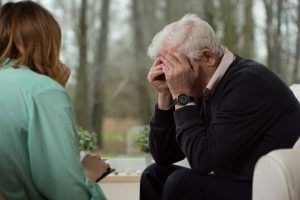 Antidepressant therapy may vary among the elderly with late-life depression, as it becomes more difficult to treat the older the individual is. The study, published in JAMA Psychiatry, examined longitudinal patterns of changes in depressive symptoms in those who were prescribed antidepressant therapy.
Antidepressant therapy may vary among the elderly with late-life depression, as it becomes more difficult to treat the older the individual is. The study, published in JAMA Psychiatry, examined longitudinal patterns of changes in depressive symptoms in those who were prescribed antidepressant therapy.
Lead author of the study Stephen F. Smagula said, “Elderly patients with late-life depression should get treated, that is the main take-home message from this study. You should get treated, and you should stay with it. Some of these patients take 12 weeks or more to fully respond. Late-life depression is often difficult to treat, and solo venlafaxine is just not going to cut it for a lot of the patients out there. But get treated, stay with it, and also explore adjunctive care or alternatives, as indicated.”
Advertisement
The study reports that nearly 50 percent of seniors with late-life depression have difficulties responding to initial antidepressant therapy.
For the research, which took place between August 2009 and August 2014, participants received antidepressant therapy, which was upped to 300 mg/day over the course of 12 weeks. They found that late-life depression was difficult to treat, and there were different responses to the antidepressant therapy.
Almost half of the participants showed responses to the treatment, but there were three subgroups who did not respond to treatment. Two of the subgroups had high baseline depression levels and the other had moderate baseline depression levels. Dr. Smagula added, “This finding suggests that despite older age and depressive illness, relative preservation of retention ability, which is associated with hippocampal function, may facilitate a rapid response. This hypothesis is consistent with prior evidence linking hippocampal volume to late-life depression treatment outcomes.”
Researchers commented that late-life depression is difficult to treat because depression among the elderly is not well studied. Commenter of the study Dr. Robert Roca added, “It is clear that depression severity by itself does not reliably predict antidepressant response among older adults. Much work remains to be done. We may ultimately be disappointed in our quest to discover robust clinical predictors of response and in the end may need to look to biomarkers for guidance.”
Prevalence and statistics of late-life depression in seniors
With the rise of illness, disability, and other life changes through the aging process, late-life depression affects many seniors. Chronic depression in the elderly can have both mental and physical consequences, which can, in turn, worsen underlying medical conditions.
It is reported that late-life depression affects nearly six million seniors over the age of 65, yet only 10 percent ever receive treatment for it. The problem surrounding late-life depression in the elderly is that symptoms are often confused with other diseases and ailments, so misdiagnosis is common.
Depression in the elderly differs from depression in younger adults because it increases their risk of heart failure, cardiac disease, and death from other illnesses. Suicide rates are also higher among white males with late-life depression, nearly double when compared to that of the general population.
Symptoms of depression in the elderly
For successful early diagnosis of late-life depression, it’s important to recognize the symptoms in elderly people and not confuse them with other ailments. Symptoms of depression in the elderly include:
- Sadness
- Fatigue
- Lost interest in activities or hobbies
- Social withdrawal or isolation
- Weight loss or loss of appetite
- Difficulties sleeping, staying asleep
- Loss of self-worth
- Increased use of alcohol or other substances
- Fixation on death, suicidal thoughts
- Anxiety and irritability
- Aches and pains
- Memory problems
- Lack of motivation or energy
- Slowed movement or speech
- Loss of interest in socializing
- Feeling hopeless or helpless
- Neglecting personal care (hygiene, feeding oneself, forgetting medications)
Causes and risk factors for depression in the elderly
There are many causes and risk factors which put the elderly at higher risk for late-life depression. With all the changes resulting from aging, causes and risk factors of depression in the elderly include:
- Health problems, like a pre-existing illness or disability
- Loneliness or isolation
- Reduced sense of purpose – no longer working or taking care of family members
- Fear – of dying, financial instability, health issues
- Recent bereavements
- Being single, unmarried, or widowed
- Lack of social support or social interactions
- Stressful life events
- Medications
- Family history of major depression
- Chronic pain
Prevention and self-help tips for depression in the elderly
Advertisement
Late-life depression doesn’t have to affect you simply because you are getting older. Preventative measures can be taken in order to avoid or lower a person’s risk of developing late-life depression. Prevention and self-help tips for depression in the elderly involve:
Creating a social support group – volunteering at churches or in the community, calling up loved ones, visiting friends and family
- Exercising – exercise has been shown to have positive mood-boosting effects
- Recognizing and reducing stress triggers or creating coping strategies
- Reaching out for help when you feel overwhelmed, lonely, or helpless
- Getting enough sleep – if you have a condition that prevents or hinders sleep, speak with a doctor to combat this
- Maintaining a healthy diet – there are many foods that have mood-boosting effects
- Getting a pet
- Learning a new skill
- Laughing more
- Becoming aware of physical limitations – don’t try to partake in activities that go beyond your limitations as you increase your risk to “fail,” which can contribute to depression.
The older you become the greater your risk is to develop late-life depression, but with simple preventative techniques you can continue enjoying a happy, fulfilled life.
